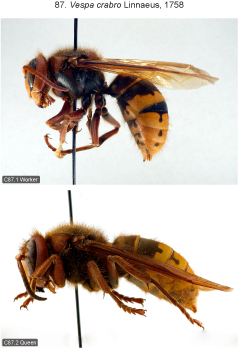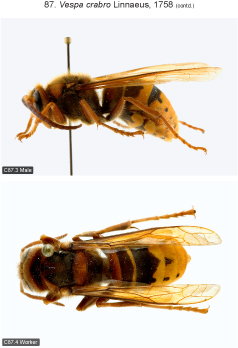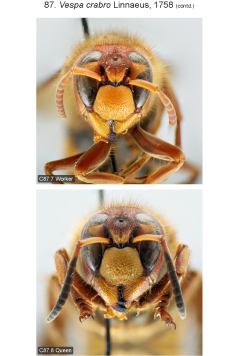
| Home | Table of contents | Keys | Species list | Glossary | Image data | PDF | Cite this article | Feedback | Updates |
Identification Atlas of the Vespidae (Hymenoptera, Aculeata) of the northeastern Nearctic region
CJAI 05, February 19, 2008
doi: 10.3752/cjai.2008.05
Matthias Buck, Stephen A. Marshall, and David K.B. Cheung
Department of Environmental Biology, University of Guelph, Guelph, Ontario, Canada N1G 2W1
87. Vespa crabro Linnaeus, 1758 – European Hornet
Figs B11.1, 5; C87.1–10.
 |
 |
 |
 |
 |
Species recognition. The European hornet is easily recognised by its large size, head shape and colouration.
Variation. Fore wing length 16–20 mm (workers), ca. 22–24 mm (♀♀, n = 5), ca. 22 mm (♂♂, n = 3). The colour pattern of this species is fairly constant. Males (always?) have black markings in and in front of the ocellar area and extending laterally to the antennal bases. In females these markings are rarely present. The male flagellum has strongly developed tyloids (two on each flagellomere except flagellomere I which has only one). The extent of ferruginous markings is slightly variable; ferruginous markings are (nearly) absent in specimens from eastern Europe and the eastern Palaearctic region.
Distribution. Canada: ON and QC (new record; sighted in Aylmer in 2004/5 by H. Goulet, pers. comm.). Eastern U.S.: MA to GA, AL, and MI, west to ND, SD, IN, KY and TN. Widespread in Palaearctic region from Europe to Sakhalin, Japan, northern China, and Taiwan (Carpenter and Kojima 1997). First introduced to the Nearctic region in the New York area between 1840 and 1860 (Akre et al 1981).
Biology. Nests are usually built in hollow trees and other cavities such as hollow walls, attics, barns, and abandoned bee hives; very rarely they are below ground. The nest is surrounded by an envelope of wood fibres when built in more exposed situations; nests in confined spaces have only a rudimentary envelope. Various kinds of insects (including honey bees and yellowjackets) serve as prey. Unlike other North American Vespinae the adults are also active at night and are attracted to light. Workers girdle twigs and branches of various trees and shrubs in order to feed on sap. The European hornet occurs mostly in woodlands and is rarely a nuisance (Akre et al. 1981).
| Home | Table of contents | Keys | Species list | Glossary | Image data | PDF | Cite this article | Feedback | Updates |
